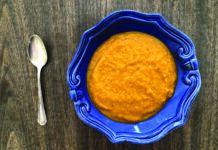Whole grains can help fght the belly fat thats linked to heart disease and diabetes, according to Tufts researchers, while refined grains like white bread and pasta can cancel out those benefits.Observational studies have linked higher intakes of whole grains to lower abdominal adipos- ity; however, the association between whole- and refned- grain intake and body fat compartments has yet to be reported, noted Nicola McKeown, PhD, a scientist in Tufts HNRCA Nutritional Epi- demiology Program and program director of Nutrition Epidemiology at the Friedman School, and colleagues in the American Journal of Clinical Nutrition.So McKeown and colleagues analyzed data on 2,834 men and women, ages 32 to 83, participating in the renowned Framingham Heart Study. Dietary informa- tion was assessed using a food-frequency questionnaire, and results were adjusted for other lifestyle factors such as smok- ing and alcohol consumption, as well as calorie intake. Researchers compared grain intake with individuals abdominal subcutaneous adipose tissue (SAT) and visceral adipose tissue (VAT)-essentially, belly fat. Such fat around the abdominal organs is particularly unhealthy, and is a factor in metabolic syndrome, a precursor to heart disease and diabetes.People who reported eating three or more daily servings of whole grains and who limited their intake of refned grains to less than one serving a day averaged 10% lower VAT volume. Eating more whole grains was also associated with lower SAT, while people consuming more refned grains tended to have greater SAT volumes.In this study, a serving of whole grains was considered one cup of whole-grain breakfast cereal, such as oat cereal; half a cup of cooked oatmeal, brown rice or other grains; one slice of dark bread; three cups of popcorn; or two tablespoons of added bran or added germ, such as wheat germ. Refned grains included processed break- fast cereals, white bread, English muffns, bagels, muffns, biscuits, white rice, pasta, pancakes, waffes, crackers and pizza.McKeown and colleagues reported that the VAT-fghting benefts of whole grains were diminished among people also eating four or more daily servings of refned grains. McKeown commented, This result implies that it is important to make substitutions in the diet, rather than simply adding whole- grain foods.How much whole grains should you aim to include in your diet? The American Heart Association recommends getting at least three one-ounce-equivalent servings of fiber-rich whole grains per day. American Journal of Clinical Nutrition, November 2010; abstract at <www.ajcn.org/cgi/ content/abstract/92/5/1165> Whole Grains Council <wholegrainscouncil.org>
- #7213 (no title)
- About
- Cart
- Checkout
- Contact the Editor
- Contact Us
- Content restricted
- Customer Service
- Glossary
- Nutrition 101 – Glossary – J
- Nutrition 101 – Glossary – K
- Nutrition 101 – Glossary – L
- Nutrition 101 – Glossary – M
- Nutrition 101 – Glossary – N
- Nutrition 101 – Glossary – O
- Nutrition 101 – Glossary – P
- Nutrition 101 – Glossary – Q
- Nutrition 101 – Glossary – R
- Nutrition 101 – Glossary – S
- Nutrition 101 – Glossary – T
- Nutrition 101 – Glossary – A
- Nutrition 101 – Glossary – B
- Nutrition 101 – Glossary – C
- Nutrition 101 – Glossary – D
- Nutrition 101 – Glossary – E
- Nutrition 101 – Glossary – F
- Nutrition 101 – Glossary – G
- Nutrition 101 – Glossary – H
- Nutrition 101 – Glossary – I
- Nutrition 101 – Glossary – U
- Nutrition 101 – Glossary – V
- Nutrition 101 – Glossary – W
- Nutrition 101 – Glossary – X
- Nutrition 101 – Glossary – Y
- Nutrition 101 – Glossary – Z
- Manage Email
- My Account
- OFIE – Subscriber only
- Online Account Activation
- Privacy Policy
- Products
- Products
- Register
- Register
- Registration Complete
- Registration Complete
- Sample Page
- Settings
- Subscribe
- Subscribe Now
- Tufts & Health Nutrition
- Tufts & Health Nutrition | JH Inforce
- Tufts & Health Nutrition | JHV Employee
- Tufts & Health Nutrition | John Hancock
- Tufts & Health Nutrition | Manulife Asia
- Tufts & Health Nutrition | Manulife Vitality
- Tufts & Health Nutrition | NU101
- Tufts & Health Nutrition | Tufts Employees
Copyright 2020 Tufts University Health & Nutrition Letter



















